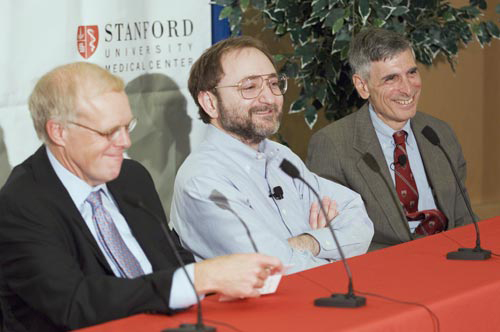October 4, 2006

Stanford President John Hennessy, Nobel Laureate Andrew Fire and Philip Pizzo, dean of the School of Medicine, appeared together at a press conference.
At a time when public funding of basic bioscience is being scaled back, Stanford’s two newest Nobel laureates used their moments in the spotlight to underscore how essential such money is to the future of medical breakthroughs. Both Andrew Fire, PhD, and Roger Kornberg, PhD, said that without it, their own research would never have come to fruition.
Both Kornberg and Fire were cheered this week by colleagues and the public for accomplishments in research that focus on the basic mechanisms of life at the molecular level—research that may appear to nonscientists as somewhat abstract but that scientists say is likely to lead eventually to cures for diseases that range from cancer to heart disease.
For this type of research to continue to thrive, public funding for organizations, most notably the NIH, must flourish, they said. Yet funding for the NIH was cut this year for the first time in more than 30 years, and the administration’s budget proposal for next year would freeze the NIH budget at that level, meaning a decline in spending power when inflation is factored in.
“This is a day to remind each of us about the importance of funding basic research,” Philip Pizzo, MD, dean of the School of Medicine said Oct. 4 at the second Nobel Prize press conference on his campus in three days. “At a time when our country in some ways is questioning the integrity of science and the NIH is struggling to support work that is very meritorious, this is incredible evidence of the extraordinary applications of basic science.”
Over the course of 37 years, the NIH reports it has provided more than $24 million to support Kornberg’s research. It’s given nearly $8.5 million to support the work of Fire and his colleague Craig Mello, PhD. Fire, a professor of pathology and of genetics, and Mello, of the University of Massachusetts, shared the Nobel Prize in Physiology or Medicine on Oct. 2 for their work in discovering the mechanism know as RNA interference that can selectively turn off genes within a cell.
When Fire first submitted a grant to the NIH to fund his work on roundworms 20 years ago, he said he had no idea it would someday spawn a flurry of new research that could allow scientists to silence genes that cause diseases from HIV to cancer.
“We did what we could based on the support, as it turns out, of the American people,” Fire said. “I don’t know if that grant would have been funded today.”
Kornberg echoed the same concern for the future of NIH budget.
“The awarding of these kinds of prizes make scientists even more acutely aware of the need to press onward and for the continued support of basic science so that real rewards can be reaped,” Kornberg said.
About Stanford Medicine
Stanford Medicine is an integrated academic health system comprising the Stanford School of Medicine and adult and pediatric health care delivery systems. Together, they harness the full potential of biomedicine through collaborative research, education and clinical care for patients. For more information, please visit med.stanford.edu.